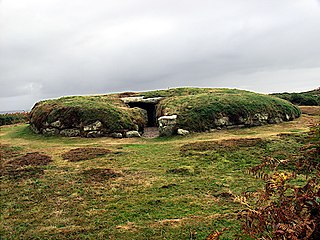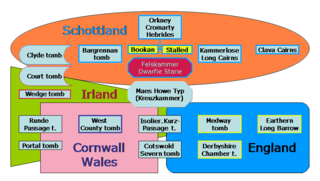
John Robert Mortimer was an English corn-merchant and archaeologist who lived in Driffield, East Riding of Yorkshire.

A tumulus is a mound of earth and stones raised over a grave or graves. Tumuli are also known as barrows, burial mounds or kurgans, and may be found throughout much of the world. A cairn, which is a mound of stones built for various purposes, may also originally have been a tumulus.

Porth Hellick Down is a Neolithic and Bronze Age archeological site located on the island of St Mary's, in the Isles of Scilly in Great Britain. The ancient burial monument encompasses a large cairn cemetery that includes at least six entrance graves, other unchambered cairns, and a prehistoric field system. The site is notable for having the largest assembly of surviving entrance graves.
The Arras culture is an archaeological culture of the Middle Iron Age in East Yorkshire, England. It takes its name from the cemetery site of Arras, at Arras Farm, (53.86°N 0.59°W) near Market Weighton, which was discovered in the 19th century. The site spans three fields, bisected by the main east-west road between Market Weighton and Beverley, and is arable farmland; little to no remains are visible above ground. The extent of the Arras culture is loosely associated with the Parisi tribe of pre-Roman Britain.

Chariot burials are tombs in which the deceased was buried together with their chariot, usually including their horses and other possessions. An instance of a person being buried with their horse is called horse burial.
Canon William Greenwell, was an English archaeologist and Church of England priest.

Kilmartin Glen is an area in Argyll not far from Kintyre. It has the most important concentration of Neolithic and Bronze Age remains in mainland Scotland. The glen is located between Oban and Lochgilphead, surrounding the village of Kilmartin. In the village, Kilmartin Museum explains the stories of this ancient landscape and the people who dwelt there. There are more than 800 ancient monuments within a six-mile radius of the village, with 150 monuments being prehistoric. Monuments include standing stones, a henge monument, numerous cists, and a "linear cemetery" comprising five burial cairns. Several of these, as well as many natural rocks, are decorated with cup and ring marks.

Hob Hurst's House is a Bronze Age barrow on Beeley Moor near Bakewell in Derbyshire. It is unique in that instead of the normal round shape, Hob Hurst's barrow is rectangular. Originally made with 13 stones, only five remain today.

The remains of an Iron Age chariot burial were found near the Bronze Age burial mound at Huly Hill, Newbridge in Scotland, 14 km west of Edinburgh city centre, in advance of development at the Edinburgh Interchange. The chariot was the first of its kind to be found in Scotland and shows Iron Age Scotland in direct contact with the European Continent. The Newbridge chariot was buried intact, a method consistent with the burial practices of Continental Europe rather than Yorkshire.

Cawthorne Camp is a Roman site in north-east England, about 4 miles (6 km) north of Pickering, North Yorkshire. The well-preserved earthworks outline two forts, one with an extension, and a temporary camp built to an unusual plan. The earthworks date from the late 1st/early 2nd century AD. It has been suggested that they were built for practice rather than for actual military use.

Wetwang Slack is an Iron Age archaeological site containing remains of the Arras culture and chariot burial tradition of East Yorkshire. Archaeological investigation took place in 2001 and 2002.

Danes Graves is an archaeological site in the East Riding of Yorkshire. It forms part of the Arras Culture of inhumation and chariot burial prevalent in the region during the British Iron Age. It is a prehistoric cemetery site situated in Danesdale – a dry river valley with gravel and chalk deposits. The site is north of Driffield near the village of Kilham.

Burton Fleming is an Iron Age archaeological site from the Arras culture of East Yorkshire. The site is named from the parish of Burton Fleming within which the Iron Age cemetery lies, and is closely associated with the Iron Age barrows at Rudston.

British megalith architecture is the study of those ancient cultures that built megalithic sites on the British Isles, including the research and documentation of these sites. The classification sometimes used of these cultures based on geological criteria is problematic.

John Lamplugh Kirk M.R.C.S was a British medical doctor, amateur archaeologist and founder of York Castle Museum in York, North Yorkshire.
William Hardy "Bill" Lamplough was a British teacher and archaeologist based in Yorkshire.

The Pocklington Iron Age burial ground is a prehistoric cemetery discovered in 2014 on the outskirts of Pocklington in the East Riding of Yorkshire, England. Excavations carried out on an ongoing basis since then, have uncovered more than 160 skeletons and more than 70 square barrows thought to date to the Middle Iron Age that are attributed to the Arras culture, an ancient British culture of East Yorkshire. A variety of grave goods have been found along with the human remains, including weapons, beads, pots, and a rare chariot burial.

Oxley Grabham (1864-1939) MA was a British naturalist, ornithologist, and museum curator.

Gibbet Moor is a small gritstone upland area in the Derbyshire Peak District of central and northern England, near the village of Baslow. Its highest point is 295 metres (968 ft) above sea level. The Chatsworth Estate lies to the west and Umberley Brook run along its east edge. East Moor is the broader moorland area covering Gibbet Moor, Brampton East Moor and Beeley Moor. Gibbet Moor is a prehistoric landscape with several protected Scheduled Ancient Monuments.
Ian Mathieson Stead is a British archaeologist and curator, specialising in the British Iron Age.
















